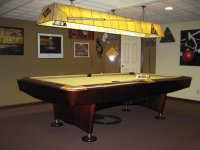Sorry...You had told me you were a coin op mechanic doing 1000 coin ops a year. Did not realize you did alot of Gold Crowns back then. I know you work on alot now. I am going on info from Jay Speilberg. Who has been working on Gold Crowns since 1970. He could be mistaken though.
Pat, read the following:
In the United States and CanadaThe best known American variety of bluestone is a feldspathic sandstone, which is produced in hundreds of small quarries in adjacent areas of Pennsylvania and New York. It is also quarried in the Canadian Appalachians near Deer Lake in Western Newfoundland.[2] The Pennsylvania Bluestone Association has 105 members, the vast majority of them quarriers. The other, lesser known, type of American bluestone is formed from a different sedimentary rock, limestone. The limestone is abundant in the Shenandoah Valley of Virginia yet The Frazier Quarry [www.frazierquarry.com] is the only remaining quarry that cuts dimension stone from it.
Bluestone from Pennsylvania and New York is commercially known as bluestone or Pennsylvania Bluestone. These are a group of sandstones defined as feldspathic greywacke. The sand-sized grains from which bluestone is constituted were deposited in the "Catskill Delta" during the Middle to Upper Devonian Period of the Paleozoic Era, approximately 370 to 345 million years ago. If the initial deposit was made under slow moving water the ripples of the water action on the sand or mud will be revealed. This deposition process may be seen today at any ocean beach in shallow water or in a stream bed where conditions allow it to be observed. The term "bluestone" is derived from a deep-blue-colored sandstone first found in Ulster County, New York.
The Catskill Delta was created from run off from the Acadian Mountains ("Ancestral Appalachians") which covered the area where New York City now exists. This Delta ran in a narrow band from southwest to northeast and today provides the base material for the high-quality bluestone which is quarried from the Catskill Mountains (and Northeast Pennsylvania).
As the product became more popular as an architectural and building stone and demand grew, quarrying for it spread throughout south central New York and northeast Pennsylvania. It is a unique commodity of particular value to the economy of Susquehanna County, Pennsylvania.
Bluestone from the Shenandoah Valley is regionally known as bluestone but a less ambiguous name is Shenandoah Valley Bluestone. The limestone formed during the Ordovician Period approximately 450 to 500 million years ago, but it was formed at the bottom of a relatively shallow ocean that then covered what is today Rockingham County, Virginia. However, the limestone that accumulated in Rockingham County was darker in color than most other limestone deposits because it was in deeper waters exposed to less light. The darker blue color resulted in limestone from this region to be dubbed bluestone and with two sequences measuring about 10,000 ft, it gives the area one of the largest limestone deposits in the world. The stone eventually fades from a deep blue to a light grey after prolonged exposure to the sun.Given the abundance of the stone in the Rockingham County area, the first settlers used it as foundations and chimneys for their houses. When James Madison University was built, the native bluestone was used to construct the buildings because of its high quality and cultural ties.
